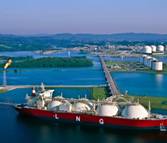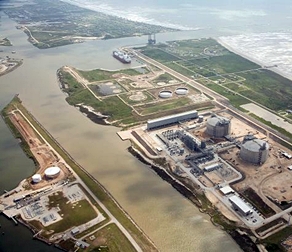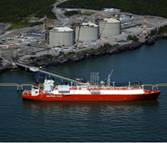US Gulf, Western Canada vie for big gas projects
By CHESTER DAWSON and BEN LEFEBVRE
PORT EDWARD, British Columbia -- Some of the world's largest energy companies are racing to transform backwaters like this hamlet of 544 people into boomtowns.
The energy giants are proposing half a trillion dollars in projects to export vast new finds of North American natural gas. Western Canada and the US Gulf Coast are competing to see which region receives the lion's share of the investment.
Port Edward has been shrinking since the canneries and pulp mills began shutting decades ago. But it has a deepwater port that could someday handle the huge ships that carry liquefied natural gas. And Malaysia's state-owned energy giant Petronas says it is prepared to spend $20 billion on a terminal, pipeline and other infrastructure here.
 A drilling revolution in the US and Canada has unlocked a glut of natural-gas reserves across the continent. That has sent prices tumbling-a boon for consumers and industrial users. But it has also sent energy companies scrambling for a way to profit by sending the cheap gas to Asia, where demand and prices are high.
A drilling revolution in the US and Canada has unlocked a glut of natural-gas reserves across the continent. That has sent prices tumbling-a boon for consumers and industrial users. But it has also sent energy companies scrambling for a way to profit by sending the cheap gas to Asia, where demand and prices are high.
Producers largely have divided up into two camps: One is betting on Canada's industry-friendly federal government and its closer proximity to Asia. The other group is hoping already-developed infrastructure in the US will outweigh political uncertainty in Washington over large-scale exports of the cheap fuel.
Industry executives say most of the projects announced so far in the two regions won't be built, so companies are jostling to be first out of the gate. Eurasia Group, a research and consulting firm, estimates energy companies eventually could spend $50 billion converting existing liquid-gas import plants in the US into export plants, while they may shell out an additional $60 billion to build such plants from scratch in Canada.
That spending spree will help shape energy prices around the world for decades to come. Currently, natural gas sells for just $4 per British thermal unit in North America but $16/BTU in Asia. Using LNG always will be more expensive than locally produced gas because converting gas into liquid, transporting it, and converting it back into gas is costly. But exporting LNG still can help narrow the price gap between North America and Asia, shaving power bills for manufacturers and consumers abroad.
The biggest economic impact will be in North America itself. The British Columbia government estimates that a single LNG plant will cost as much as $20 billion, creating 3,500 construction jobs and 200 to 300 permanent jobs.
"We can be the second-largest exporter of liquefied natural gas in the world," said British Columbia Premier Christy Clark, who is contemplating a $100 billion "prosperity fund" from expected tax revenue. "When we reach our potential for liquefied natural gas, it will have the same impact on Canada's national economy that the oil sands in Alberta have had."
Those backing US plants have a different take.
"The reality of it is that the additional cost to build the pipeline and liquefaction equipment in such a remote and pristine area will raise the cost so much that their advantage of lower shipping will be completely eliminated," said Michael Smith, chief executive of Freeport LNG in Freeport, Texas.
Martin Houston, chief operating officer for BG Group, the UK gas giant, acknowledges that challenge, but cites shorter sailing times to Asia as a key selling point for Canada. Shipments from Western Canada take eight to 10 days to reach East Asia, less than half the time it takes from the US Gulf Coast. Still, BG is hedging its bet with a proposed plant on both sides of the border.
"We see a world in which global supply will be challenged to keep up with global demand," said Mr. Houston.
As recently as 2007, North America was preparing for a gas shortage and building terminals to import LNG, not ship it offshore. But with the advent of the North American gas boom, many of the import terminals have seen little business.
Now they are being converted to export terminals at around $10 billion apiece.
 So far, the US government has approved two projects for LNG exports, with Freeport as one of them. A debate rages in Washington over whether to allow more. Some industry groups say the gas should stay on the continent, to ensure cheap energy for US manufacturing and consumers.
So far, the US government has approved two projects for LNG exports, with Freeport as one of them. A debate rages in Washington over whether to allow more. Some industry groups say the gas should stay on the continent, to ensure cheap energy for US manufacturing and consumers.
There is no such debate in Canada. Ottawa has approved three export applications, including projects led by Chevron and Royal Dutch Shell. Four others filed this summer are pending -- including one large-scale plant by ExxonMobil and two more major terminals by BG Group and Petronas.
None of them have yet fully committed to a Canadian project. Before spending the billions of dollars necessary for an LNG-export plant, they want long-term contracts for the gas. So they are courting Asian buyers or recruiting them as partners for their projects. Asian buyers, meanwhile, are pushing to get the gas as cheaply as possible before they commit.
Few in the energy industry doubt that Asian buyers will sign deals for Canadian gas. The best evidence is the number of Asian companies that have taken equity stakes in Canadian LNG projects or snapped up tracts of gas-rich ground in western Canada.
Just the same, Apache and two former partners struggled to line up buyers for its Canadian LNG project on the site of an abandoned pulp mill in the coastal town of Kitimat. Many were spooked by the companies' lack of experience in LNG and the high prices the consortium sought to cover upfront costs, according to company and industry officials. The project got a boost after Chevron, a giant with deep pockets, bought in late last year.
"Chevron brings financial strength, operating experience and marketing expertise to the project," said Apache spokesman Paul Wyke.
Freeport's Mr. Smith says projects in the US had a different challenge. Amid deep reservations in Washington about letting large-scale LNG exports go forward, planners realized their success lining up buyers would be determined by their place in the permit line. Freeport won the second recent US export license in May.
As projects on both sides of the border compete for LNG buyers, a boomtown mentality has taken hold along isolated stretches of Canada's north Pacific coastline, where practically no LNG infrastructure exists currently. The epicenter of the excitement is a handful of small coastal communities some 350 miles northwest of Vancouver and less than 50 miles from Alaska, like Port Edward, with ice-free harbors year round.
Companies would need to build berths, gas-liquefaction plants and the pipelines running to gas fields hundreds of miles inland. Petronas paid over $5 billion for Canadian gas producer Progress Energy to get access to the gas reserves that would feed its proposed plant in Port Edward.
Chinese state-owned energy giant Cnooc Ltd. has expressed interest in nearby Digby Island, home to Prince Rupert's single-runway airport, and another site 16 miles farther north, local officials say. Last year, Cnooc spent $15.1 billion buying Nexen, another Canadian energy firm with significant gas holdings in British Columbia.
"The LNG industry appears to be caught up in a gold rush along this coast," said Jack Mussallem, mayor of Prince Rupert, population 11,838, which shares a deep-water port with Port Edward. "We're getting new inquiries monthly."
 The community of Kitimat, 125 miles southeast of Prince Rupert, is also bracing for change. Situated at the end of a picturesque fiord popular with salmon fishermen, groups led by Chevron, Shell and a smaller consortium have snapped up abandoned industrial and native-owned lands for proposed LNG terminals.
The community of Kitimat, 125 miles southeast of Prince Rupert, is also bracing for change. Situated at the end of a picturesque fiord popular with salmon fishermen, groups led by Chevron, Shell and a smaller consortium have snapped up abandoned industrial and native-owned lands for proposed LNG terminals.
"We've probably seen every world class energy company come and visit us over the past year," said Rose Klukas, economic development officer in Kitimat, whose city hall operates out of a partially vacant shopping mall.
Tim Hortons Inc. opened its first coffee-and-doughnut store in Kitimat in December. The town expects its first hotel to break ground by year's end, and town officials changed its bylaws in June to allow escort services, expecting an onslaught of temporary workers.
The town welcomes all the new attention after a period of economic malaise. In 2010, West Fraser Timber Co. shut a paper mill after 40 years in Kitimat.
"We feared our home equity had gone to zero overnight," Ms. Klukas said. Today, real-estate prices have rebounded, with home sales doubling last year, according to local real-estate agents.
Driving all the activity are huge shale-gas formations in the Western Canada Sedimentary Basin, which make up the bulk of the nearly 1,300 trillion cubic feet of known "tight gas" resources in Canada that could contain more than 100 years' of gas at current production levels, according to the Canadian Society for Unconventional Gas. Long thought too costly to tap, horizontal drilling and hydraulic fracturing, or fracking, now promise to unlock much of that gas, trapped in shale and other rock.
 Getting it to Asia won't be simple. At the Chevron-Apache project in Kitimat, bulldozers are leveling dirt at the site at a cost of hundreds of millions of dollars, but no formal construction date has been set for the project, already two years behind its original timetable.
Getting it to Asia won't be simple. At the Chevron-Apache project in Kitimat, bulldozers are leveling dirt at the site at a cost of hundreds of millions of dollars, but no formal construction date has been set for the project, already two years behind its original timetable.
Work crews at the site in the lower Kitimat valley are busy installing some 1,600 ground panels to stabilize the soft soil after removing 100,000 square feet of clay prone to liquefying. And a pipeline has yet to be built to carry gas hundreds of miles, over a coastal mountain range, from fields near the interior border with Alberta.
"All projects have their challenges," said Joe Geagea, Chevron's global natural gas marketing chief. "We have not seen anything that cannot be overcome with good engineering and good planning."
Back in Port Edward, Petronas has awarded preliminary contracts for pipelines and other engineering work, and expects to make a final investment decision next year. While publicly pursuing separate facilities, Petronas and BG are discussing ways of possible collaboration, said people familiar with the companies' plans.
"There are so many proposals out there," said Greg Kist, president of Pacific Northwest LNG, the name of the Petronas-backed project. "It's about who's got all the pieces in place at one point in time."
Geological surveys began the last week of June on the small, brush-covered islet called Lelu Island it has leased for the LNG facility. Mr. Kist says it could soon be swarming with 3,500 workers building the first two of three planned trains, or facilities, for super-chilling 18 million tons of gas annually from 2018.
But first it needs a bridge. A 500-foot span of water separates the uninhabited island from Port Edward proper. Local residents say Lelu Island, with no roads or electricity, is a popular recreational spot. Shawn Pettitt, the town's volunteer fire chief, lives within sight of the island and recalls family outings there.
"This community needs the jobs," he said. "But I'm sure going to miss the fishing and swimming."
In the early 2000s, soaring gas prices triggered plans to build dozens of LNG import terminals in the US. In 2008, Cheniere Energy opened the doors on one such facility in Cameron Parish, Louisiana. But by then, a revolution in drilling and extraction was unlocking vast new reserves of gas at home.
Demand for imports fell, and Cheniere laid off much of the staff. In his Houston office, Cheniere CEO Charif Souki keeps a model of an LNG cargo ship his company bought at the time to bring in the gas imports. The company was forced to sell the ship at a distressed price.
"A bad memory," Mr. Souki calls it.
Today, the facility is suddenly at the front of the pack in the new race to export gas. Cheniere is spending $12 billion to expand the plant to super-chill gas into a liquid state for sea shipment. Its first shipment is expected in late 2015, and should be the first to hit the market.
Dow Jones Newswires






Comments